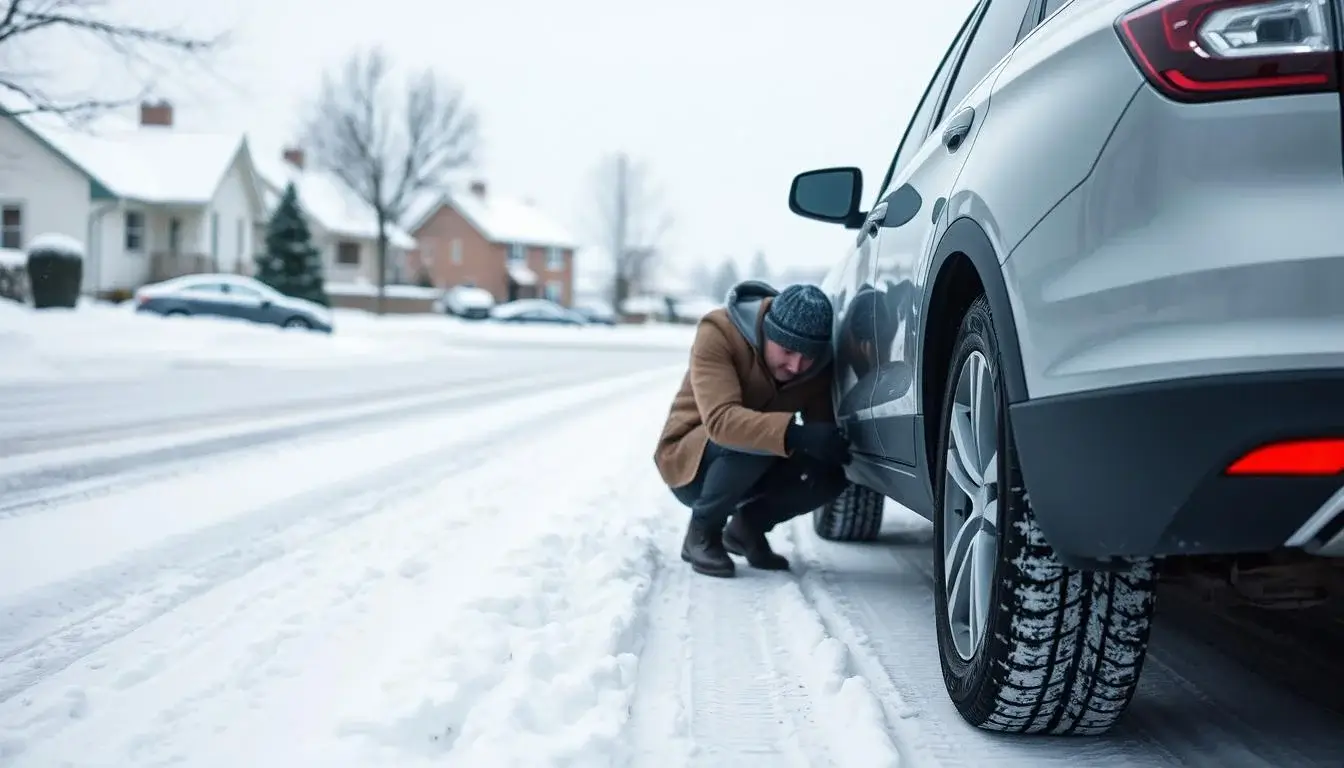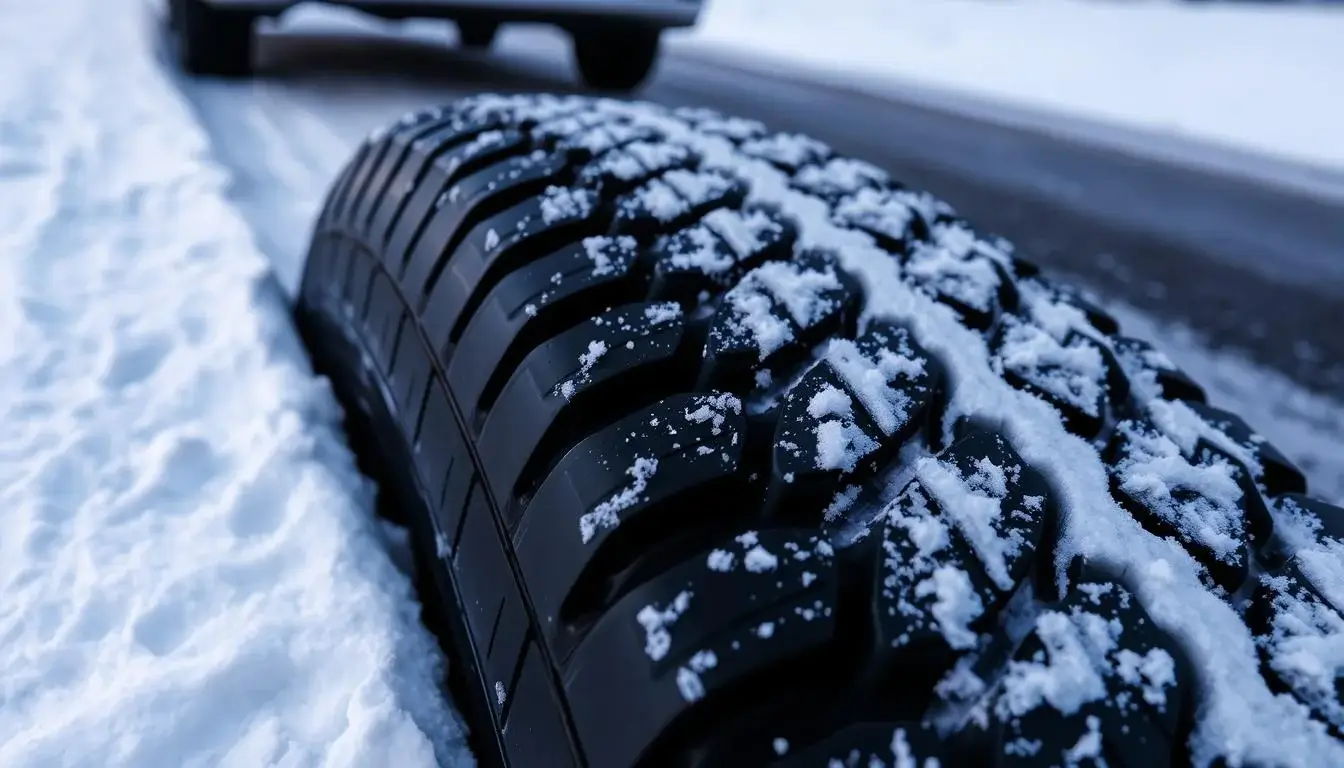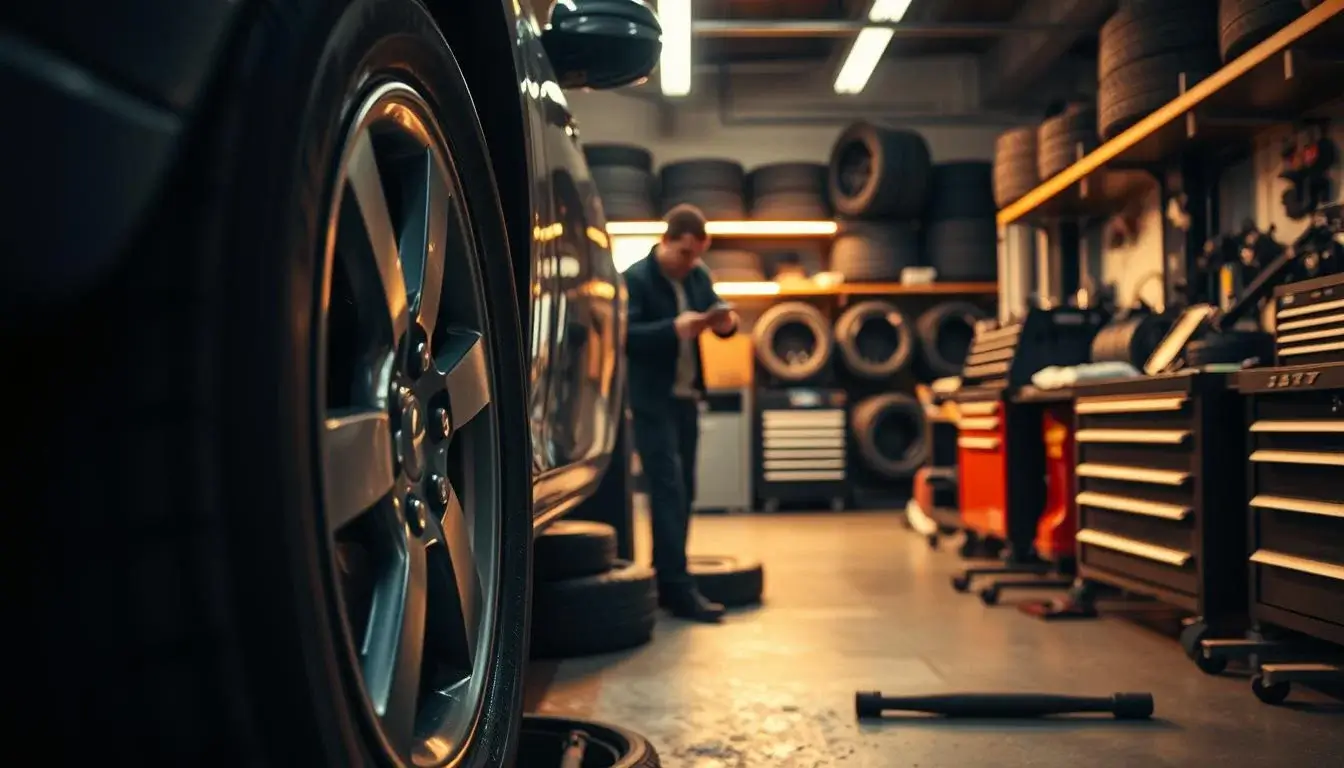Are you risking your safety by waiting too long to switch to winter setup? As the weather gets colder and roads get slippery, knowing when to switch is key. This guide will show you the best time when to put on and remove winter tires.
Choosing the right time for snow tires isn’t just about the calendar. It’s about knowing your local weather, watching temperature changes, and seeing when it’s time to switch. By timing your ice-ready tire installation right, you’ll make your car safer and better on icy or snowy roads.
Whether you’re used to driving in winter or it’s your first time, this guide will help you make smart choices about cold-season tires. We’ll look at temperature tips, regional advice, and common mistakes to avoid. This way, you’ll be confident and safe driving in winter.
Key Takeaways
- Install snow-ready tires when temperatures consistently drop below 7°C (45°F)
- Consider your local climate when deciding on winter tire timing
- The “Thanksgiving to Tax Day” rule is a helpful guideline for many regions
- Proper timing of winter wheel setup installation significantly improves safety
- Avoid mixing tire types and pay attention to wear patterns
Understanding Winter Tire Temperature Guidelines
It’s important to know when to put on winter traction tire for safe driving in cold weather. The right time ensures your tires work best in winter, making icy roads safer.
The 7°C (45°F) Temperature Rule
Switch to Ice and snow tires when daily temperatures stay below 7°C (45°F). At this point, all-season tires lose traction because their rubber hardens. Winter tires stay soft in cold, giving better grip on snow and ice.
Monitoring Daily Temperature Patterns
Watch weather forecasts to know when to use Low-temperature tires. For example, Seattle’s highs of 39°F (4°C) and lows of 27°F (-3°C) mean it’s time for winter tires. Billings, MT, with highs around 6°F (-14°C), definitely needs winter tires for safe driving.
Regional Climate Considerations
If you live where winters are harsh, put on winter tires early. The Pacific Northwest, Northern Plains, Midwest, and Northeast face tough winters. A big winter storm is forecasted for February 5, 2025, hitting these areas. So, switch to winter tires before the first snow.
“State law requires commercial motor vehicles to carry and use snow chains as directed by local signage.”
Choosing the right tires is key to staying safe in winter. Don’t wait for the first snow to switch – prepare early for winter.
When to Put on and Remove Winter Tires
It’s important to know when to put snow tires on your car and when to take them off. This ensures safe driving and the best tire performance. Let’s look at the best times for winter tire changes and some helpful tips.
Fall Installation Timeline
The best time to put on winter tires is before the first snow or when it gets colder than 7°C (45°F). This usually happens in late fall. But, the exact time can vary by region. Keep an eye on local weather and temperature to find the best time for your area.
Spring Removal Guidelines
When spring comes, you’ll need to know when to switch to summer tires. A good rule is to switch when temperatures stay above 7°C (45°F) every day. This is usually in early to mid-spring, depending on where you live. Don’t wait too long, as winter tires wear out faster in warmer weather.
The Thanksgiving to Tax Day Rule
A common rule is to use winter tires from Thanksgiving to Tax Day (April 15th in the US). But, this rule doesn’t fit everyone. Always think about your local weather and climate when deciding to switch to summer tires.
| Season | Tire Type | Installation Period |
|---|---|---|
| Winter | Snow Tires | Late Fall (November) |
| Summer | All-Season/Summer Tires | Early Spring (April) |
Remember, these guidelines can be adjusted. If you’re not sure when to switch to summer tires or if it’s too early for winter tires, talk to a local tire expert. They can give advice based on your driving conditions and vehicle.
Safety Benefits of Proper Tire Timing
Getting your winter tires on at the right time is key for staying safe in the cold. Winter tires are made to give you better grip and traction on snow and ice. This makes your car perform better in tough weather.
Enhanced Traction in Cold Conditions
Winter tires have a special rubber that stays soft in the cold. This softness helps your car grip icy roads better. The deep tread and sipes (tiny slits) push snow and slush away, keeping your tires in touch with the road.
Braking Distance Improvements
Winter tires also make your car stop faster on icy roads. Tests show cars with winter tires stop up to 30% sooner than those with all-season tires. This can save lives in emergencies.
| Tire Type | Braking Distance (60-0 mph on ice) |
|---|---|
| Winter Tires | 156 feet |
| All-Season Tires | 223 feet |
| Summer Tires | 351 feet |
Winter Accident Prevention
Putting on winter tires on time can greatly lower your risk of accidents in winter. They offer better traction, braking, and control. Always slow down and keep a safe distance from others, no matter the weather.
🚗 Don’t Wait – Get Your Winter Tires Before It’s Too Late!
By now, you understand the importance of switching to winter tires at the right time. Whether you’re dealing with icy roads, freezing temperatures, or unpredictable winter weather, having the right cold-weather tires is essential for safety and control.
❄️ Be prepared before the first snowfall! Find the best winter tires for your vehicle today and drive with confidence all season long.
Storage and Maintenance of Seasonal Tires
Storing winter tires right is key to keeping them in good shape when not in use. Learning how to store them at home can save money and make them last longer. Here are some tips to keep your tires in great condition.
First, make sure your tires are clean. Wash them well and let them dry completely. This stops dirt and grime from harming the rubber. After drying, put each tire in a big, airtight plastic bag to shield it from moisture and ozone.
It’s also important to keep tires away from sunlight. Sunlight’s UV rays can damage the rubber, leading to cracks and early wear. Store them in a cool, dry spot like a basement or garage. If you can, use tire racks to keep them off the ground and keep their shape.
- Clean tires thoroughly before storage
- Use airtight bags for protection
- Store in a cool, dry place
- Keep tires off the ground
If you’re short on space, you can stack your tires. But don’t stack them too high, as this can warp them. Rotate the stack now and then to avoid flat spots.
| Storage Method | Pros | Cons |
|---|---|---|
| Tire Rack | Saves space, maintains shape | Initial cost |
| Stacking | Space-efficient | Potential deformation |
| Hanging | Prevents flat spots | Requires sturdy hooks |
By using these storage tips, your tires will be ready for winter. Proper storage not only extends their life but also keeps them performing well. This ensures your safety on winter roads.
Common Mistakes to Avoid in Seasonal Tire Changes
Knowing when to switch to winter tires is key for your safety. Many ask, “Is it bad to put winter tires on early?” The answer is complex. Early installation might wear them out faster, but being ready for winter is better than being caught off guard.
Timing Your Tire Change
Putting on winter tires too early or taking them off too late can cause problems. If you’re wondering, “What happens if you leave winter tires on all year?” They’ll wear out quicker in warm weather. The rubber made for cold weather gets damaged by hot pavement.
Mixing Tire Types
Can you mix winter and all season tires? It’s not a good idea. Using all season tires with winter ones can make your car harder to handle and less safe. For the best performance, use only winter tires.
Monitoring Wear Patterns
How often to replace winter tires depends on how they wear. Always check the tire pressure and look at the tread depth. Winter tires usually last 3-4 seasons, but heavy use can shorten their life. Keeping them well-maintained can make them last longer.
| Mistake | Consequence | Solution |
|---|---|---|
| Early installation | Faster wear on warm roads | Wait until temperatures consistently drop below 7°C |
| Late removal | Reduced performance, increased wear | Remove when spring temperatures stay above 7°C |
| Mixing tire types | Compromised handling and safety | Use a full set of winter tires |
| Ignoring wear patterns | Reduced traction, safety risks | Regular inspections, timely replacements |
Avoiding these common mistakes ensures your winter tires work best during the cold months.
Ready to Make the Switch? Get Your Winter Tires Today!
You now know when to put on and remove winter tires—but knowing isn’t enough! The right set of winter tires can make all the difference in your safety, handling, and overall driving confidence.
Don’t wait until the roads are covered in snow and ice. Make the switch now and experience better traction, improved braking performance, and superior control in low temperatures.
🚙 Find the perfect winter tires for your car and drive safely this season!
Conclusion
Choosing the right tire is key for safety and performance. The need for winter tires varies based on your local climate and driving habits. Studded tires should only be used when absolutely necessary, as they can damage roads.
Regular tires might be enough for milder winters, but cold-weather performance tires offer better traction and handling. The 7°C (45°F) rule is a good guide for when to switch. Changing your tires at the right time can greatly improve your safety during winter.
By following this advice, you’ll be ready to make smart choices about your vehicle’s tires all year. Always put safety first by keeping your tires in good condition and choosing the right ones for the season.
👉 Want to learn more about why winter tires matter? Check out our in-depth guide on how winter tires make a difference and how to choose the best ones:
🔗 Do Winter Tires Make a Difference? How to Choose the Best Ones?
FAQ
When is the best time to change to winter tires?
The best time to change to winter or snow tires is when daily temperatures drop below 7°C (45°F). Winter tires are specifically designed to perform in cold temperatures, providing better braking performance and control on snow or ice. This usually happens in late fall, but the timing depends on the climate in your area.
How do I know when to switch from summer to winter tires?
A general rule of thumb is to make the switch from summer tires to winter tires installed when you experience consistent low temperatures below 7°C (45°F). If you live in an area with frequent icy conditions, switching earlier can help improve tire performance on slippery roads.
Can I use all-season tires for winter?
While all-season tires can handle mild winter conditions, they are not designed for extreme winter weather or ice and snow. Winter tires are specifically built with a special rubber compound and deeper tread patterns to provide better grip in low temperatures. If you drive in harsh winter conditions, snow tires (another name for winter tires) are a much safer choice.
How long does it take to get winter tires installed?
Getting winter tires installed usually takes 30 minutes to an hour at a tire shop. If you choose to do it yourself, the process may take longer, depending on your experience. It’s always best to check if your vehicle is front-wheel drive, rear-wheel drive, or all-wheel drive before installation.
Is it okay to use winter tires in the summer?
No, using winter tires in the summer is not recommended. Winter tires are specifically made with a special rubber compound that stays flexible in cold temperatures but wears out quickly on dry roads in warm weather. If you drive on winter tires in the spring or summer, they will degrade faster and have reduced braking performance.
When should I remove my winter tires?
You should change to summer tires or all-season tires when the temperature stays consistently above 7°C (45°F). This transition typically happens in early spring, but it depends on your region’s climate. Driving winter tires on dry roads in warm weather causes unnecessary wear, reducing their lifespan.
Why do winter tires perform better in icy conditions?
Winter tires are specifically designed to handle icy conditions with a combination of:
Deep tread patterns that improve traction
Sipes (tiny slits) in the tread that help channel water and slush away
A special rubber compound that stays flexible in low temperatures
These features ensure better braking performance and handling in winter weather.
Can I use only two winter tires instead of four?
Using just two winter tires is not recommended. Mixing winter and summer or all-season and winter tires can cause uneven handling, reducing stability. For the best safety and performance, always use a full set of winter tires.
Are studded winter tires better than regular winter tires?
Studded tires provide extra grip on ice and snow, but they are not always necessary. If you live in an area with frequent icy conditions, using studded tires can help. However, studded tires are noisy, wear out dry roads faster, and are even restricted in some states. Consider all-weather tires or winter tires with deep tread if your region has mixed conditions.
How should I store my winter tires when not in use?
When removing your winter tires, store them away from direct sunlight, in a cool, dry place. Clean them before storage, and use tire bags to protect them. Keeping the tires properly stored can extend their lifespan for multiple seasons.
How often should I replace my winter tires?
A replacement tire is needed when the tread depth is 4/32 of an inch or less. Typically, winter tires last 4-6 seasons, but this depends on road conditions and how often you drive. Check your tire’s condition before each winter to ensure they still perform effectively.
Is there a rule to remember when changing winter tires?
Yes! The “Thanksgiving to Tax Day” rule suggests putting on winter tires installed around Thanksgiving and removing them around Tax Day in the U.S. However, this is a general rule of thumb—the actual best time to change depends on the temperatures in your area.



